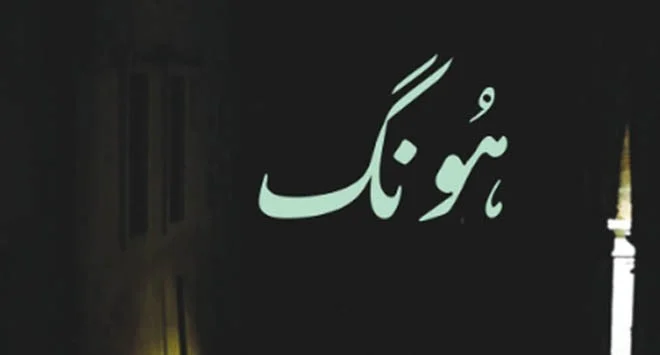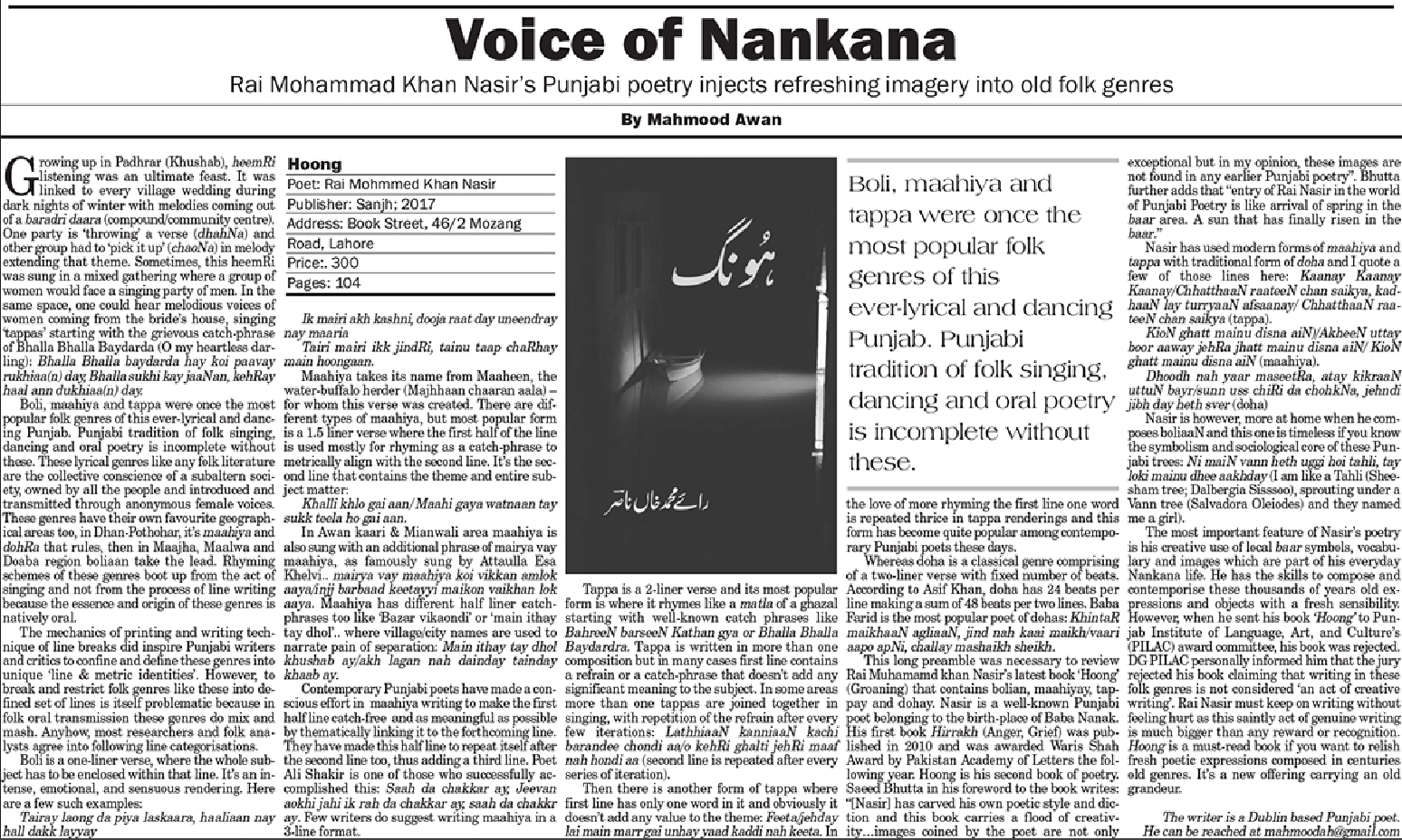Mahmood Awan (The News on Sunday, 29th April 2018)
Growing up in Padhrar (Khushab), heemRi listening was an ultimate feast. It was linked to every village wedding during dark nights of winter with melodies coming out of a baradri daara (compound/community centre). One party is ‘throwing’ a verse (dhahNa) and other group had to ‘pick it up’ (chaoNa) in melody extending that theme. Sometimes, this heemRi was sung in a mixed gathering where a group of women would face a singing party of men. In the same space, one could hear melodious voices of women coming from the bride’s house, singing ‘tappas’ starting with the grievous catch-phrase of Bhalla Bhalla Baydarda (O my heartless darling): Bhalla Bhalla baydarda hay koi paavay rukhiaa(n) day, Bhalla sukhi kay jaaNan, kehRay haal ann dukhiaa(n) day.
Boli, maahiya and tappa were once the most popular folk genres of this ever-lyrical and dancing Punjab. Punjabi tradition of folk singing, dancing and oral poetry is incomplete without these. These lyrical genres like any folk literature are the collective conscience of a subaltern society, owned by all the people and introduced and transmitted through anonymous female voices. These genres have their own favourite geographical areas too, in Dhan-Pothohar, it’s maahiya and dohRa that rules, then in Maajha, Maalwa and Doaba region boliaan take the lead. Rhyming schemes of these genres boot up from the act of singing and not from the process of line writing because the essence and origin of these genres is natively oral.
The mechanics of printing and writing technique of line breaks did inspire Punjabi writers and critics to confine and define these genres into unique ‘line & metric identities’. However, to break and restrict folk genres like these into defined set of lines is itself problematic because in folk oral transmission these genres do mix and mash. Anyhow, most researchers and folk analysts agree into following line categorisations.
Boli is a one-liner verse, where the whole subject has to be enclosed within that line. It’s an intense, emotional, and sensuous rendering. Here are a few such examples:
Tairay laong da piya laskaara, haaliaan nay hall dakk layyay
Ik mairi akh kashni, dooja raat day uneendray nay maaria
Tairi mairi ikk jindRi, tainu taap chaRhay main hoongaan.
Maahiya takes its name from Maaheen, the water-buffalo herder (Majhhaan chaaran aala) – for whom this verse was created. There are different types of maahiya, but most popular form is a 1.5 liner verse where the first half of the line is used mostly for rhyming as a catch-phrase to metrically align with the second line. It’s the second line that contains the theme and entire subject matter:
Khalli khlo gai aan/ Maahi diyaa(n) watnaan tay sukk teela ho gai aan.
In Awan kaari & Mianwali area maahiya is also sung with an additional phrase of mairya vay maahiya, as famously sung by Attaulla Esa Khelvi.. mairya vay maahiya koi vikkan amlok aaya/injj barbaad keetayyi maikon vaikhan lok aaya. Maahiya has different half liner catch-phrases too like ‘Bazar vikaondi’ or ‘main ithay tay dhol’.. where village/city names are used to narrate pain of separation: Main ithay tay dhol khushab ay/akh lagan nah dainday tainday khaab ay.
Contemporary Punjabi poets have made a conscious effort in maahiya writing to make the first half line catch-free and as meaningful as possible by thematically linking it to the forthcoming line. They have made this half line to repeat itself after the second line too, thus adding a third line. Poet Ali Shakir is one of those who successfully accomplished this: Saah da chakkar ay, Jeevan aokhi jahi ik rah da chakkar ay, saah da chakkr ay. Few writers do suggest writing maahiya in a 3-line format.
Tappa is a 2-liner verse and its most popular form is where it rhymes like a matla of a ghazal starting with well-known catch phrases like BahreeN barseeN Kathan gya or Bhalla Bhalla Baydardra. Tappa is written in more than one composition but in many cases first line contains a refrain or a catch-phrase that doesn’t add any significant meaning to the subject. In some areas more than one tappas are joined together in singing, with repetition of the refrain after every few iterations: LathhiaaN kanniaaN kachi barandee chondi aa/o kehRi ghalti jehRi maaf nah hondi aa (second line is repeated after every series of iteration).
Then there is another form of tappa where first line has only one word in it and obviously it doesn’t add any value to the theme: Feeta/jehday lai main marr gai unhay yaad kaddi nah keeta. In the love of more rhyming the first line one word is repeated thrice in tappa renderings and this form has become quite popular among contemporary Punjabi poets these days.
Whereas doha is a classical genre comprising of a two-liner verse with fixed number of beats. According to Asif Khan, doha has 24 beats per line making a sum of 48 beats per two lines. Baba Farid is the most popular poet of dohas: KhintaR maikhaaN agliaaN, jind nah kaai maikh/vaari aapo apNi, challay mashaikh sheikh.
This long preamble was necessary to review Rai Muhamamd khan Nasir’s latest book ‘Hoong’ (Groaning) that contains bolian, maahiyay, tappay and dohay. Nasir is a well-known Punjabi poet belonging to the birth-place of Baba Nanak. His first book Hirrakh (Anger, Grief) was published in 2010 and was awarded Waris Shah Award by Pakistan Academy of Letters the following year. Hoong is his second book of poetry. Saeed Bhutta in his foreword to the book writes: “[Nasir] has carved his own poetic style and diction and this book carries a flood of creativity…images coined by the poet are not only exceptional but in my opinion, these images are not found in any earlier Punjabi poetry”. Bhutta further adds that “entry of Rai Nasir in the world of Punjabi Poetry is like arrival of spring in the baar area. A sun that has finally risen in the baar.”
Nasir has used modern forms of maahiya and tappa with traditional form of doha and I quote a few of those lines here: Kaanay Kaanay Kaanay/ChhatthaaN raateeN chan saikya, kadhaaN lay turryaaN afsaanay/ ChhatthaaN raateeN chan saikya (tappa).
KioN ghatt mainu disna aiN)/AkheeN uttay boor aaway jehRa jhatt mainu disna aiN/ KioN ghatt mainu disna aiN (maahiya).
Dhoodh nah yaar maseetRa, atay kikraaN uttuN bayr/sunn uss chiRi da chohkNa, jehndi jibh day heth sver (doha)
Nasir is however, more at home when he composes boliaaN and this one is timeless if you know the symbolism and sociological core of these Punjabi trees: Ni maiN vann heth uggi hoi tahli, tay loki mainu dhee aakhday (I am like a Tahli (Sheesham tree; Dalbergia Sisssoo), sprouting under a Vann tree (Salvadora Oleiodes) and they named me a girl).
The most important feature of Nasir’s poetry is his creative use of local baar symbols, vocabulary and images which are part of his everyday Nankana life. He has the skills to compose and contemporise these thousands of years old expressions and objects with a fresh sensibility.
However, when he sent his book ‘Hoong’ to Punjab Institute of Language, Art, and Culture’s (PILAC) award committee, his book was rejected. DG PILAC personally informed him that the jury rejected his book claiming that writing in these folk genres is not considered ‘an act of creative writing’. Rai Nasir must keep on writing without feeling hurt as this saintly act of genuine writing is much bigger than any reward or recognition. Hoong is a must-read book if you want to relish fresh poetic expressions composed in centuries old genres. It’s a new offering carrying an old grandeur.
Poet: Rai Mohmmed Khan
Nasir Publisher: Sanjh; 2017
Address: Book Street, 46/2 Mozang Road, Lahore
Price:. 300
Pages: 104
Published on 29th April 2018 in The News on Sunday.
https://www.thenews.com.pk/tns/detail/565397-voice-nankana


